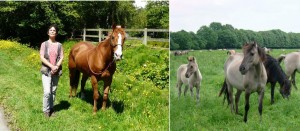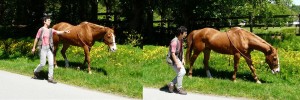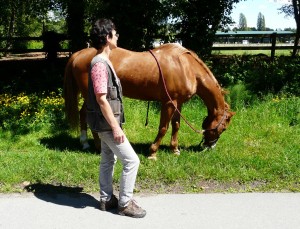Playing – with Knowledge – Part 05
|
|
Fachmännisch Spielen – Teil 05
|
- With all we have learned so far, we can dare hit the road! We know how to behave like a friend and how to lead – or at least we think we know, and now will put it to the test, whether the horse understands our intentions and respects them! Once you master the “Going for a walk” game by mere body language, you have learned your first Liberty Game! And an important one!
Going for a walk:
- It is always wise to attempt new things in a setting, where the horse is likely to want to cooperate – so a grazing situation is very propitious, because it puts the horse into a good mood at least – even if he chooses to ignore you over the allurement of the grass at first!
The rope:
- Of course you will start on the rope to be safe! I use a fairly long lead-rope and put a knot at the very end of it. I never wrap or even loop it around my hand, but rather hold it folded, so I can drop the rope quickly in such a way that just the knot remains in my hand. Should the horse ever spook, you want to give him all the rope you can fast, as he, as a flight animal, must be allowed to move his feet, when scared. Never pull on a frightened horse – you´ll just make the situation worse!
- Separate the functions of rope hand and whip hand as in all other exercises. In the second phase of learning you can throw the rope over the horse´s back (on the outside) and hang on lightly at the dangling end – you are still in control, but the horse does not feel it much. In the third phase the horse will obey you at liberty as shown on my pictures.
Where to walk?
- This will of course depend on the placement of your stable – for us it is the boulevard along the road, for you it may be a path in the country. No matter – know the challenges! It may be tractors or car traffic, whizzing mountain bikes or coyotes, ducks flying up out of ditches or aggressive dogs.
|
|
- Mit allem, was wir bisher gelernt haben, können wir uns nun auf die Straße wagen. Wir wissen, wie man sich als Freund verhält und wie man führt – wenigstens denken wir das, und nun werden wir testen, ob das Pferd unsere Absichten versteht und respektiert! Wer das Spiel „Spazierengehen“ nur mit Körpersprache beherrscht, hat seine erste Freiheitsdressur erreicht – und eine wichtige!
Wir gehen spazieren:
- Es ist immer gut neue Dinge in einer Situation zu versuchen, in der das Pferd vermutlich mitmachen will – und daher ist Grasengehen vielversprechend, da es so wenigstens gute Laune hat, selbst wenn es Sie über der Versuchung des Grünzeugs zuerst ignoriert!
Das Seil:
- Natürlich fangen wir am Seil an, um auf Nummer sicher zu gehen. Ich benutze ein ziemlich langes Führseil mit einem Knoten am Ende. Ich wickele es niemals um meine Hand und halte es nicht einmal in Schlaufen, sondern nur doppelt, so daß ich es blitzschnell so fallen lassen kann, daß nur der Knoten in meiner Hand bleibt. Sollte das Pferd scheuen, so muß man ihm das ganze Seil schnell auslassen, denn es muß als Fluchttier seine Füße bewegen dürfen, wenn es Angst hat! Ziehen Sie nie an einem ängstlichen Pferd – das macht alles nur noch schlimmer!
- Trennen Sie die Funktionen von Seil- und Gertenhand wie in allen anderen Übungen auch. In der zweiten Lernphase kann man das Seil von außen über den Rücken des Pferdes werfen und das lose hängende Ende in der Hand halten – so hat man noch Kontrolle, aber das Pferd fühlt es nicht sehr. In der dritten Phase wird das Pferd in Freiheit gehorchen, wie hier auf meinem Bildern gezeigt.
Wohin gehen?
- Das kommt natürlich auf die Lage des Stalls an – bei uns geht es den Boulevard an der Straße lang, bei Ihnen vielleicht über einen Weg im Wald. Egal – vergegenwärtigen Sie sich Sie die möglichen Probleme! Das könnten Traktoren oder Verkehr sein, rasende Mountain Biker oder Koyoten (bei uns!), aus Gräben auffliegende Enten oder angriffslustige Hunde.
|
 Be in the leader position – look where you are going!
Gehen Sie in der Führerposition – schauen Sie in Bewegungsrichtung!
|
- So set out in the leader position – rope long and slack, whip in the other hand, you with your shoulder in front of the horse’s nose. Look where you are going – not at the horse! Point into the direction with your rope-hand, have your whip ready behind you to egg him on, and say “let’s go!” I think your horse will willingly follow.
- I hope you turned your cell phone off, because here starts your job as a leader. You must see all possible problems FIRST, if you want your horse to have peace of mind for enjoyable grazing, so you have to pay attention! If your horse pricks his ears and stares at something – you must look too! What kind of a figure would you cut as a leader, if your horse points to something which worries him, and you don’t even see it?? Remember that as a herd member, who accepts you as the lead-mare, he would always watch you to take all cues (to flee or not to flee) from YOU!
|
|
- Fangen Sie in der Führerposition an – mit langem durchhängendem Seil, Gerte in der anderen Hand und mit Ihrer Schulter vor der Nase des Pferdes. Schauen Sie in Bewegungsrichtung – nicht auf Ihr Pferd! Deuten Sie mit der Seilhand wo es lang geht und seien Sie mit der Peitsche bereit es von hinter Ihrem Rücken anzutreiben. Kommando „auf gehts!“ Ich denke, Ihr Pferd wird willig loslaufen.
- Ich hoffe, Sie haben Ihr Handy abgestellt, denn hier beginnt Ihr Job als Anführer. Sie müssen alle möglichen Probleme ZUERST sehen, wenn Ihr Pferd friedlich greasen können soll, daher müssen Sie aufpassen! Wenn Ihr Pferd die Ohren spitzt und etwas fixiert – da müssen Sie auch hingucken! Was für eine jämmerliche Führerfigur wären Sie in seinen Augen, wenn es etwas Bedrohliches erspäht und Sie sehen es nicht einmal?? Sie erinnern sich, daß ein Herdenmitglied, welches Sie als Anführer akzeptiert, Sie immerzu im Auge behält, um von IHNEN zu erfahren, ob es fliehen muß oder nicht!
|
 The leader must see potential problems FIRST, as the horse looks to her for further instruction – to flee or not to flee!
Der Anführer muß alle möglichen Probleme ZUERST sehen, da das Pferd von ihr erfahren muß – fliehen oder bleiben? |
Stop and Go!
- NOW comes the first problem: your horse will likely want to stop at the first tuft of grass and put his head down as soon as he sees it. What do you do? Be wise! Let him…
- But now comes the training part of our walk: If you ARE the lead-mare, then your herd (however small it may be) will follow you, as soon as you set yourself into motion.
- So after a few mouthfuls of grass eaten, you make sure you are in the correct leader position and without being in the horse’s way, lift your chest, chin up, look where you want to go and point with your rope-hand. Say “let’s go!” (this is the announcement and fair warning of what is to come), then a sharp kissing sound (this is the command!) – and if he doesn’t set himself into motion, a little smack with the whip behind your back follows instantly. In the beginning you might also have to give a sharp tug on the rope if he ignores you (but do NOT pull!) – but very soon this will be superfluous.
|
|
Stopp und Weiter!
- NUN kommt das Problem: Ihr Pferd will vermutlich am ersten Grasbüschel, das es erblickt, anhalten. Was tun Sie? Seien Sie weise! Lassen Sie es….
- Danach kommt aber der Ausbildungsteil Ihres Spaziergangs: wenn Sie wirklich die Leitstute SIND, dann muß Ihre Herde (egal wie klein) Ihnen folgen, sobald Sie sich in Bewegung setzen.
- Nach ein paar Happen Gras prüfen Sie also, daß Sie in der richtigen Führposition und dem Pferd nicht im Weg sind, heben Ihr Brustbein und Kinn an, schauen in Bewegungsrichtung und zeigen sie mit der Seilhand an. Sagen Sie „los gehts!“ (dies ist die faire Ankündigung dessen, was kommen soll) dann einen scharfen Kußton (das ist mein Kommando!) – und wenn nun das Pferd sich nicht in Bewegung setzt, tippen Sie ihn sofort deutlich mit der Gerte hinter Ihrem Rücken an. Anfangs muß man vielleicht noch einen scharfen Zupfer am Seil draufsetzen, wenn es einen ignoriert (aber NICHT ziehen!!), was aber bald überflüssig wird.
|
 When the leader goes – the herd goes. When the leader stops the others stop also!
Wenn die Anführerin losgeht, läuft die Herde los. Wenn sie anhält, halten die anderen auch!
|
Ignoring the leader is the only thing we will never allow!
- Now he moves (unless you don’t have a clue where your whip is and hit empty air) and your “good!” must also instantly follow !! Do not forget to praise!
- After three steps stop – “brrrr” or “ho!” is the voice command – change your body position to “resting”, i.e. rope-hand sinks, head goes down, feet stop moving, one leg rests without weight on it.
- If the horse doesn’t stop, also shake the rope. (See “From Leading to Liberty” for the complete chapter of “body language vocabulary) The horse will very soon understand that he is always allowed to stop again, so he will more willingly get going, when you ask for it. (Only later do we expand the phases of walking without eating further).
Resting – staying stopped:
- Even while you remain stopped, because your horse is eating, your body position speaks to him – and this is important to understand, because IF your horse respects you as his leader, he will always be watching you!
- If you want your horse to stay in one spot for a while (perhaps because a car is approaching), stand in a “body-blocking” position – in front of him and in his way (should he want to walk off) and ready to stare him into the eyes, which is a demand to yield. Keep your distance from your horse – a large “bubble” expresses your request for high rank – even when grazing!
|
|
Den Anführer zu ignorieren ist das Einzige, das wir nie erlauben!
- Jetzt läuft das Pferd (außer Sie haben keine Ahnung, wohin Ihre Gerte zeigt und haben in die Luft geschnatzt) und Ihr „brav!“ muß ebenso prompt folgen!! Vergessen Sie das Loben nicht!!
- Nach drei Schritten kann man schon halten – “brrrr” or “ho!“ ist das Kommando – und Sie ändern Ihre Körpersprache in „Ruhestellung“, d.h. Seilhand sinkt, Ihr Kopf auch, Füße halten an und ein Bein wird angewinkelt ohne Gewicht.
- Wenn das Pferd nicht anhält schütteln Sie zusätzlich das Seil. (Siehe das Kapitel der Körpersprachen-Vokabeln im Buch “From Leading to Liberty”). Das Pferd wird sehr schnell verstehen, daß es immer wieder anhalten darf, so daß es willig weitergeht, wenn Sie es verlangen. (Erst später dehnt man die Phasen des Gehens ohne Fressen weiter aus).
Ruhen – Stehen bleiben:
- Auch solange man nur rumsteht, weil das Pferd frißt, spricht man mit dem Körper zu ihm – und es ist wichtig das zu verstehen, da Ihr Pferd, FALLS es Sie als Anführer respektiert, Sie immer im Auge hat!
- Wenn Sie eine Weile an einer Stelle bleiben wollen (vielleicht weil sich gerade Autos nähern), stehen Sie in der „Körper-Blockier“ Position – also vor ihm und ihm im Weg (sollte es loslaufen wollen) und bereit ihm in die Augen zu starren, was Ihre Forderung zum Weichen wäre. Bleiben Sie vom Pferd weg – eine große „Blase“ verdeutlicht Ihren Ranganspruch – auch beim Grasen!
|
 Your body always speaks to him – my legs show “rest!”, my positions says “stay put!”
Mein Körper drückt immer etwas aus: mein Bein sagt “wir ruhen”, meine Position sagt “bleib hier!” |
Resting but ready to go:
- If however you want to give your horse the freedom to move on at random, as the next tuft of clover beckons him, you would stand in the partner position next to his shoulder. So don’t reprimand him for moving on at will if you stand there (but told him to “stay!”), this would be a contradiction of body language and voice command, which he can’t understand!
|
|
Geparkt – aber bereit zum Weiterlaufen:
- Wenn Sie Ihrem Pferd aber frei überlassen wollen, wann es weiter geht, wenn das nächste Kleebüschel ruft, dann stehen Sie in der Partnerposition neben seiner Schulter. Schimpfen Sie also nicht mit ihm, wenn es weiterläuft, wenn Sie so neben ihm standen (und „Steh!“ gesagt haben), denn das war ein Widerspruch zwischen Stimm- und Körpersprache, die es nicht verstehen kann!
|
 If I stand in the partner position, the horse is free to walk on when he chooses.
Wenn ich in der Partnerposition stehe, darf das Pferd weiterlaufen, wenn es will. |
| To be continued in the next Blog – this one became too long! Grazing is an unbelievably important topic, as your horses can tell you! |
|
Im nächsten Blog geht es weiter – die Fortsetzung, da dieser Blog zu lang wurde! Grasen ist eben ein unglaublich wichtiges Thema, wie Ihre Pferde Ihnen sagen können! |






